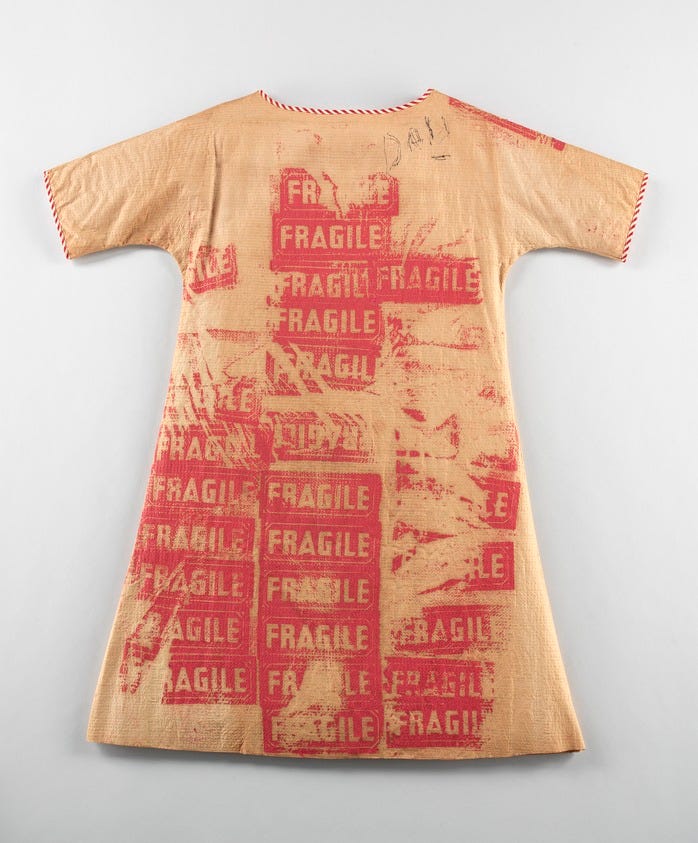Open This End: Behind the Iconic Andy Warhol's Paper Dress
The Rich History of the Iconic Andy Warhol's "Open This End" Paper Dress
Weekly writing about the art market and the convergence of art and technology. By day, I’m a partner at the Robert Fontaine Gallery and a data science consultant. By night, I write Artxiom, ideas at the intersection of art, technology, and finance.
If you haven’t subscribed, join today by subscribing here:
Open This End: Behind the Iconic Andy Warhol's Paper Dress
In 1962, Andy Warhol became one of the first Pop artists to turn his work into fashion items when he began printing popular and commercial designs onto paper dresses. These one-of-a-kind pieces were created for New York socialites, who wore them at gallery openings. Sporting one of Warhol's paper dresses during this time signified you were part of a very exclusive club.
The legendary Andy Warhol's Open This End dress (Figure 1) exemplifies his innovative approach to art and consumer culture. It embodies Warhol's knack for transforming everyday objects and text into art, challenging the boundaries between consumer culture and high fashion .The dress was part of the broader 1960s trend of paper dresses and disposable fashion, aligning with pop art's fascination with consumerism and mass production.
Executed circa 1962 - 1964 and despite being called a "paper" dress, Open This End was likely made from a cellulose and rayon blend known as "paper-like”, which was common in 1960s disposable fashion. It features a repeated pattern of white text reading "open this end" on a red background mimicking the instructions typically found on cardboard boxes (Figure 2). During this time, Warhol was at the center of the most controversial moment in art history, and the present work only fanned the flames further. As an embodiment of Warhol's commentary on consumer culture, the phrase - open this end - is ripe for discussion not only for its Duchampian origins, but also for its wonderful sexual suggestiveness, which Warhol would explore further, later in his career. Art historian, Marco Livingstone stressed about this new phenomenon:
"Such advertising icons, along with cartoons and billboards, yielded a synthesis of word and image, of art and the everyday. Fashion quickly embraced the spirit of Pop, playing an important role in its dissemination."
By using a disposable medium for fashion, Warhol blurs the lines between fine art and everyday objects, challenging traditional notions of value and permanence in art. The dress is not only a garment but also a statement about the intersection of art, commerce, and identity, embodying the playful yet critical spirit of the Pop Art movement. Warhol's work encourages viewers to reconsider their relationship with consumer goods, as the dress serves both a wearable item and an art piece, highlighting his ability to transform mundane objects into fine art.
A similar impression of Open This End is part of the Brooklyn Museum’s contemporary collection today (Figure 3, 4). The piece was created when Mars, a manufacturing plant out of Asheville, North Carolina, enlisted Andy Warhol as a spokesperson to launch a new line of Paint-Your-Own white paper dresses sold with a small watercolor set. The clever marketing ploy designed to instill the idea of paper fashion as art itself took place in Brooklyn at the Abraham & Strauss department store. Nico, the lead vocalist of Velvet Underground wore the dress and laid on a table while Andy Warhol silkscreened -FRAGILE- on the dress (Figure 6). The final product was donated to the Brooklyn Museum, validating the event as an art performance and the dress as an art object.




Similarly, Open This End has a rich provenance and has been exhibited in important galleries and museums around the world, most notably at the Venice Biennale, Summer 1996 during the art & fashion exhibition, and at the Guggenheim Museums (Bilbao and New York), and the Palais des Beaux-Arts de Bruxelles (Brussels) for the traveling show Andy Warhol: A Factory (Figure 7, 8), which ran from October 1998 to April 2000 . The work is currently on view at the Robert Fontaine Gallery , Miami Beach during the fall exhibition.
In summary, Andy Warhol's Open This End stands as a testament to his revolutionary approach to art and fashion. By merging everyday consumer goods with wearable art, Warhol challenged traditional notions of fashion and blurred the lines between high and low culture. Open This End not only embodied the spirit of 1960s Pop Art but also predicted the rise of disposable fashion and the increasing influence of mass media on personal style. As both a cultural artifact and a piece of wearable art, Andy Warhol’s paper dress continues to inspire discussions about consumerism, sustainability, and the role of art in everyday life. Ultimately, this creation remains a powerful symbol of an era that embraced change, challenged conventions, and reimagined the boundaries of art and fashion; it majestically stands as a slice of history, an extraordinary piece of culture.
Note: More information about the piece, full provenance, and exhibition history can be found at the end of the article.
ANDY WARHOL (1928-1987)
Open This End
stamped with the artist's signature 'Andy Warhol' (lower left); signed, stamped again with the artist's signature and numbered 'Andy Warhol Andy Warhol A 105.009' (on the reverse)
silkscreen ink on paper dress
38 ½ x 35 ¼ in. (97.8 x 89.5 cm.)
Executed circa 1962 - 1964
PROVENANCE
Estate of the artist
John Berggruen, San Francisco
Hirschl & Adler Modern, New York
Zaira and Marsel Mis, Brussels
Their sale; Christie's, New York, 20 February 2002, lot 156
Acquired at the above sale by the present owner
EXHIBITED
Venice Biennale, art & fashion, Summer 1996.
Kunstmuseum Wolfsburg; Kunsthalle Wien; Brussels, Palais des Beaux-Arts de Bruxelles; Bilbao, Museo Guggenheim; Porto, Fundaçao Serralves and New York, Guggenheim Museum, Andy Warhol: A Factory, October 1998-April 2000, n.p., no. 119 (illustrated).
Thanks for reading! Subscribe here to receive Artxiom in your inbox each week:





